Charles Sturt University - FDS304: Quinoa Chocolate Bites Proposal
VerifiedAdded on 2023/06/09
|9
|2438
|89
Project
AI Summary
This assignment presents a detailed product proposal for gluten-free, high-protein quinoa chocolate bites, designed to cater to health-conscious consumers and individuals with gluten sensitivities. The proposal begins with an introduction highlighting the prevalence of gluten sensitivity and the benefits of a gluten-free diet, emphasizing the use of quinoa as a high-protein alternative. It then delves into the product's originality, detailing the unique combination of quinoa with other nutritious ingredients like Prana power plant protein powder, Plamil no added sugar dark chocolate, and goji berries. A comprehensive screening process is described, including a survey to assess market viability and consumer acceptance, which led to the selection of quinoa bites over other options. The target market is identified as fitness enthusiasts, gluten-intolerant individuals, vegans, vegetarians, and busy people, with a focus on local, national, and international markets. The product description covers core benefits, form, key ingredients, characteristics, and differentiation from similar products. Production steps are outlined in a flowchart, from ingredient preparation to primary packaging, with an emphasis on preservation techniques such as sterilization to ensure a good shelf life. The conclusion reiterates the product's unique selling points and its potential for market success, particularly in addressing the growing demand for gluten-free and nutritious food options. The proposal is supported by references to relevant research articles.
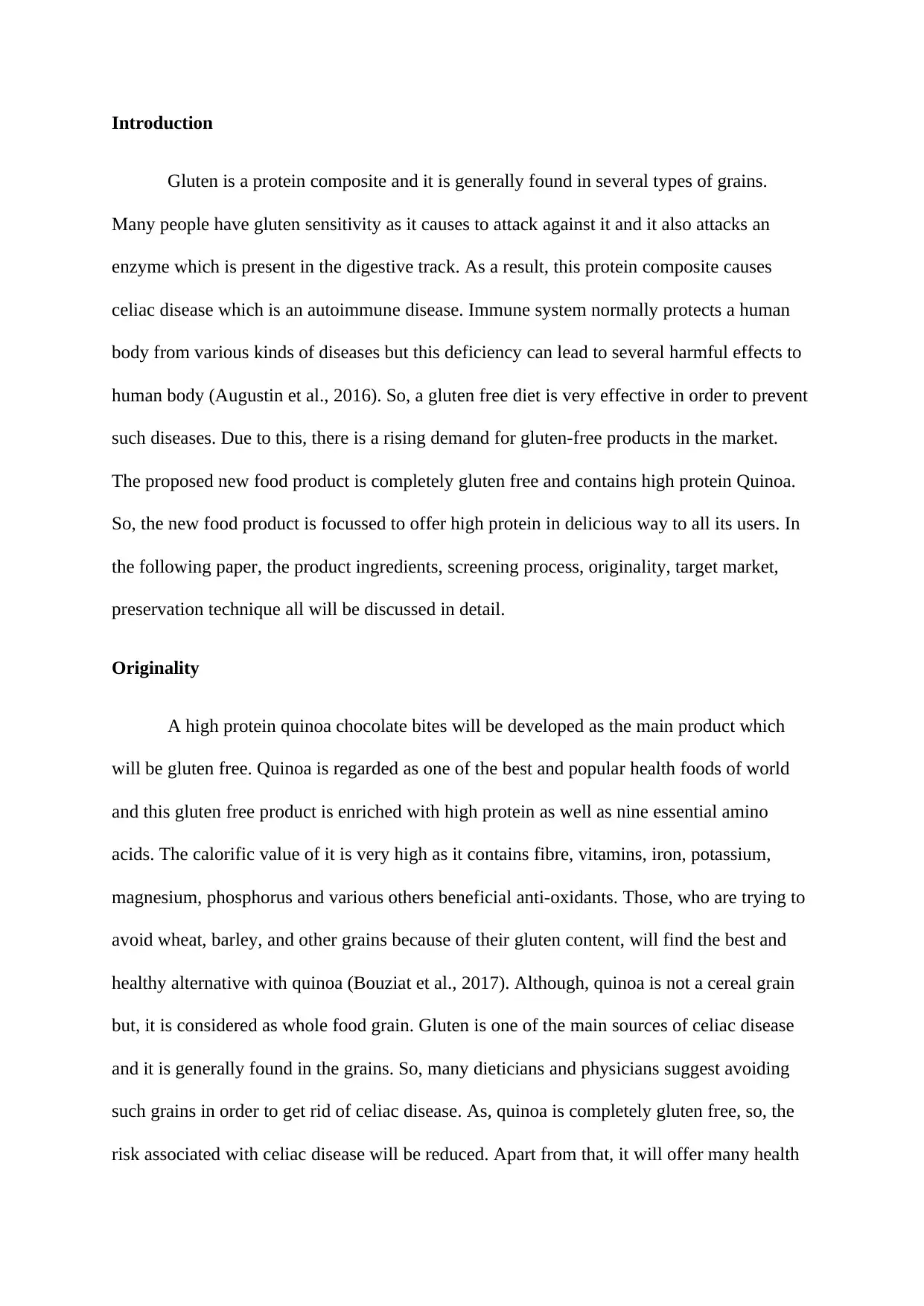
Introduction
Gluten is a protein composite and it is generally found in several types of grains.
Many people have gluten sensitivity as it causes to attack against it and it also attacks an
enzyme which is present in the digestive track. As a result, this protein composite causes
celiac disease which is an autoimmune disease. Immune system normally protects a human
body from various kinds of diseases but this deficiency can lead to several harmful effects to
human body (Augustin et al., 2016). So, a gluten free diet is very effective in order to prevent
such diseases. Due to this, there is a rising demand for gluten-free products in the market.
The proposed new food product is completely gluten free and contains high protein Quinoa.
So, the new food product is focussed to offer high protein in delicious way to all its users. In
the following paper, the product ingredients, screening process, originality, target market,
preservation technique all will be discussed in detail.
Originality
A high protein quinoa chocolate bites will be developed as the main product which
will be gluten free. Quinoa is regarded as one of the best and popular health foods of world
and this gluten free product is enriched with high protein as well as nine essential amino
acids. The calorific value of it is very high as it contains fibre, vitamins, iron, potassium,
magnesium, phosphorus and various others beneficial anti-oxidants. Those, who are trying to
avoid wheat, barley, and other grains because of their gluten content, will find the best and
healthy alternative with quinoa (Bouziat et al., 2017). Although, quinoa is not a cereal grain
but, it is considered as whole food grain. Gluten is one of the main sources of celiac disease
and it is generally found in the grains. So, many dieticians and physicians suggest avoiding
such grains in order to get rid of celiac disease. As, quinoa is completely gluten free, so, the
risk associated with celiac disease will be reduced. Apart from that, it will offer many health
Gluten is a protein composite and it is generally found in several types of grains.
Many people have gluten sensitivity as it causes to attack against it and it also attacks an
enzyme which is present in the digestive track. As a result, this protein composite causes
celiac disease which is an autoimmune disease. Immune system normally protects a human
body from various kinds of diseases but this deficiency can lead to several harmful effects to
human body (Augustin et al., 2016). So, a gluten free diet is very effective in order to prevent
such diseases. Due to this, there is a rising demand for gluten-free products in the market.
The proposed new food product is completely gluten free and contains high protein Quinoa.
So, the new food product is focussed to offer high protein in delicious way to all its users. In
the following paper, the product ingredients, screening process, originality, target market,
preservation technique all will be discussed in detail.
Originality
A high protein quinoa chocolate bites will be developed as the main product which
will be gluten free. Quinoa is regarded as one of the best and popular health foods of world
and this gluten free product is enriched with high protein as well as nine essential amino
acids. The calorific value of it is very high as it contains fibre, vitamins, iron, potassium,
magnesium, phosphorus and various others beneficial anti-oxidants. Those, who are trying to
avoid wheat, barley, and other grains because of their gluten content, will find the best and
healthy alternative with quinoa (Bouziat et al., 2017). Although, quinoa is not a cereal grain
but, it is considered as whole food grain. Gluten is one of the main sources of celiac disease
and it is generally found in the grains. So, many dieticians and physicians suggest avoiding
such grains in order to get rid of celiac disease. As, quinoa is completely gluten free, so, the
risk associated with celiac disease will be reduced. Apart from that, it will offer many health
Paraphrase This Document
Need a fresh take? Get an instant paraphrase of this document with our AI Paraphraser
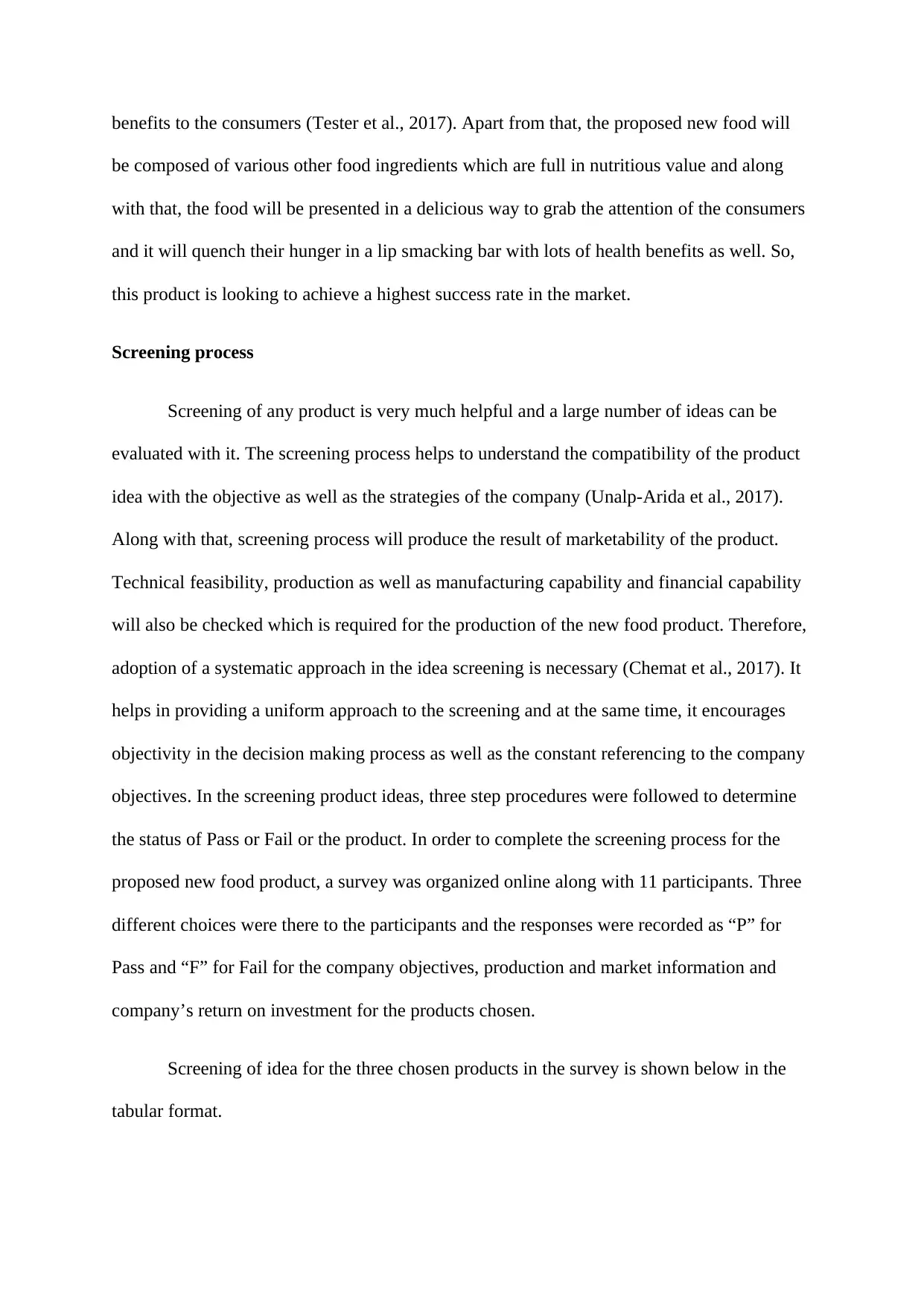
benefits to the consumers (Tester et al., 2017). Apart from that, the proposed new food will
be composed of various other food ingredients which are full in nutritious value and along
with that, the food will be presented in a delicious way to grab the attention of the consumers
and it will quench their hunger in a lip smacking bar with lots of health benefits as well. So,
this product is looking to achieve a highest success rate in the market.
Screening process
Screening of any product is very much helpful and a large number of ideas can be
evaluated with it. The screening process helps to understand the compatibility of the product
idea with the objective as well as the strategies of the company (Unalp-Arida et al., 2017).
Along with that, screening process will produce the result of marketability of the product.
Technical feasibility, production as well as manufacturing capability and financial capability
will also be checked which is required for the production of the new food product. Therefore,
adoption of a systematic approach in the idea screening is necessary (Chemat et al., 2017). It
helps in providing a uniform approach to the screening and at the same time, it encourages
objectivity in the decision making process as well as the constant referencing to the company
objectives. In the screening product ideas, three step procedures were followed to determine
the status of Pass or Fail or the product. In order to complete the screening process for the
proposed new food product, a survey was organized online along with 11 participants. Three
different choices were there to the participants and the responses were recorded as “P” for
Pass and “F” for Fail for the company objectives, production and market information and
company’s return on investment for the products chosen.
Screening of idea for the three chosen products in the survey is shown below in the
tabular format.
be composed of various other food ingredients which are full in nutritious value and along
with that, the food will be presented in a delicious way to grab the attention of the consumers
and it will quench their hunger in a lip smacking bar with lots of health benefits as well. So,
this product is looking to achieve a highest success rate in the market.
Screening process
Screening of any product is very much helpful and a large number of ideas can be
evaluated with it. The screening process helps to understand the compatibility of the product
idea with the objective as well as the strategies of the company (Unalp-Arida et al., 2017).
Along with that, screening process will produce the result of marketability of the product.
Technical feasibility, production as well as manufacturing capability and financial capability
will also be checked which is required for the production of the new food product. Therefore,
adoption of a systematic approach in the idea screening is necessary (Chemat et al., 2017). It
helps in providing a uniform approach to the screening and at the same time, it encourages
objectivity in the decision making process as well as the constant referencing to the company
objectives. In the screening product ideas, three step procedures were followed to determine
the status of Pass or Fail or the product. In order to complete the screening process for the
proposed new food product, a survey was organized online along with 11 participants. Three
different choices were there to the participants and the responses were recorded as “P” for
Pass and “F” for Fail for the company objectives, production and market information and
company’s return on investment for the products chosen.
Screening of idea for the three chosen products in the survey is shown below in the
tabular format.
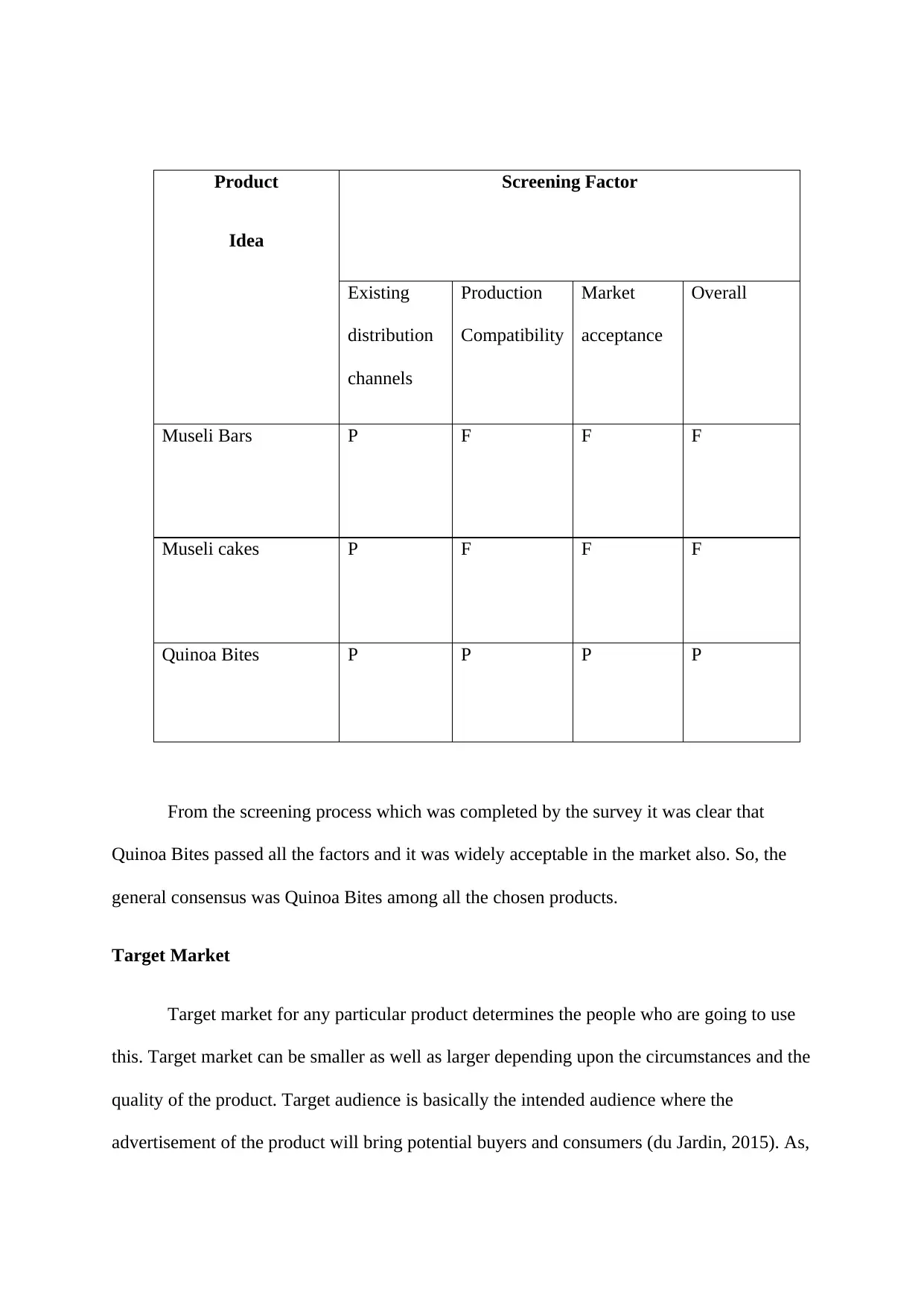
Product
Idea
Screening Factor
Existing
distribution
channels
Production
Compatibility
Market
acceptance
Overall
Museli Bars P F F F
Museli cakes P F F F
Quinoa Bites P P P P
From the screening process which was completed by the survey it was clear that
Quinoa Bites passed all the factors and it was widely acceptable in the market also. So, the
general consensus was Quinoa Bites among all the chosen products.
Target Market
Target market for any particular product determines the people who are going to use
this. Target market can be smaller as well as larger depending upon the circumstances and the
quality of the product. Target audience is basically the intended audience where the
advertisement of the product will bring potential buyers and consumers (du Jardin, 2015). As,
Idea
Screening Factor
Existing
distribution
channels
Production
Compatibility
Market
acceptance
Overall
Museli Bars P F F F
Museli cakes P F F F
Quinoa Bites P P P P
From the screening process which was completed by the survey it was clear that
Quinoa Bites passed all the factors and it was widely acceptable in the market also. So, the
general consensus was Quinoa Bites among all the chosen products.
Target Market
Target market for any particular product determines the people who are going to use
this. Target market can be smaller as well as larger depending upon the circumstances and the
quality of the product. Target audience is basically the intended audience where the
advertisement of the product will bring potential buyers and consumers (du Jardin, 2015). As,
⊘ This is a preview!⊘
Do you want full access?
Subscribe today to unlock all pages.

Trusted by 1+ million students worldwide
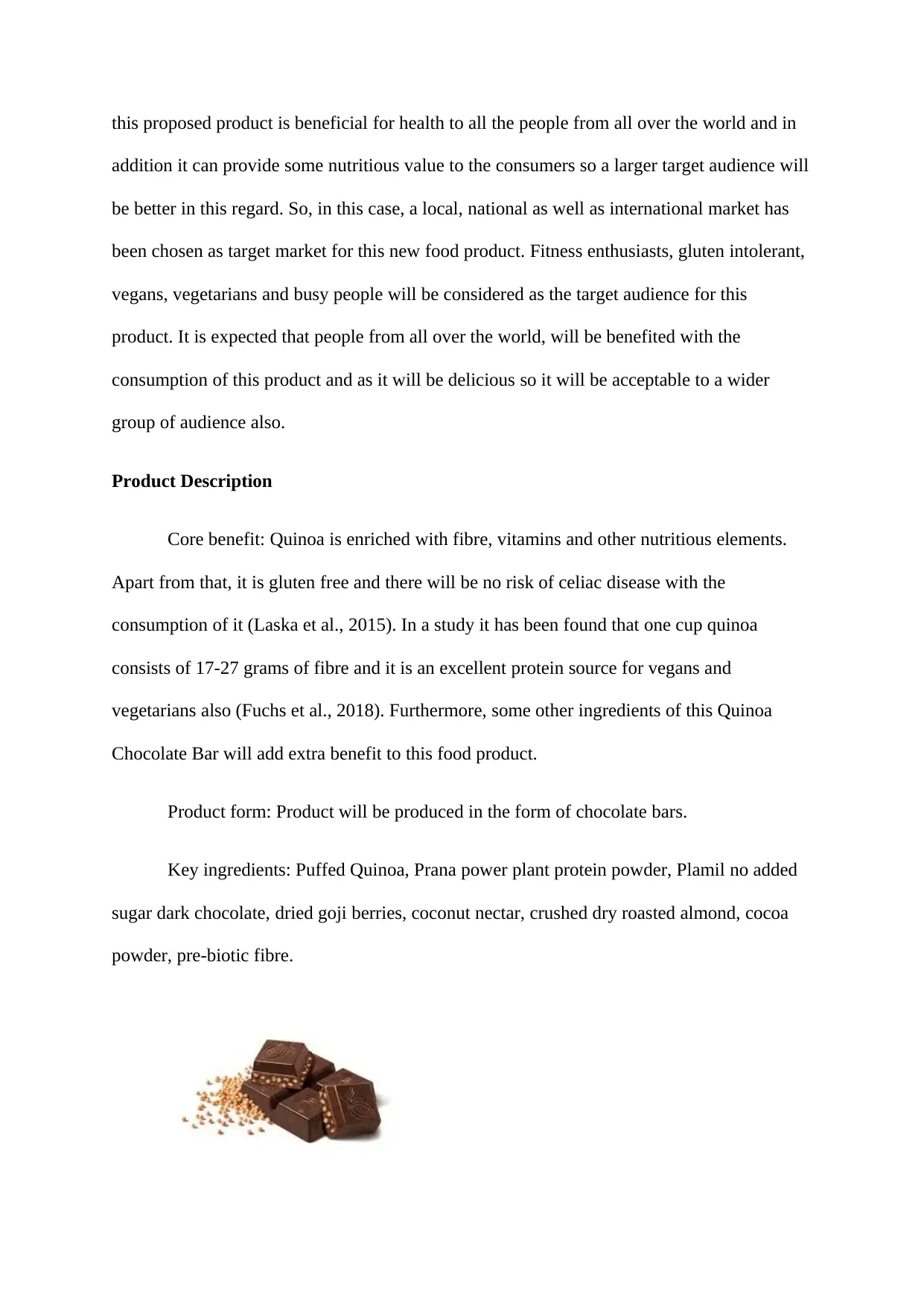
this proposed product is beneficial for health to all the people from all over the world and in
addition it can provide some nutritious value to the consumers so a larger target audience will
be better in this regard. So, in this case, a local, national as well as international market has
been chosen as target market for this new food product. Fitness enthusiasts, gluten intolerant,
vegans, vegetarians and busy people will be considered as the target audience for this
product. It is expected that people from all over the world, will be benefited with the
consumption of this product and as it will be delicious so it will be acceptable to a wider
group of audience also.
Product Description
Core benefit: Quinoa is enriched with fibre, vitamins and other nutritious elements.
Apart from that, it is gluten free and there will be no risk of celiac disease with the
consumption of it (Laska et al., 2015). In a study it has been found that one cup quinoa
consists of 17-27 grams of fibre and it is an excellent protein source for vegans and
vegetarians also (Fuchs et al., 2018). Furthermore, some other ingredients of this Quinoa
Chocolate Bar will add extra benefit to this food product.
Product form: Product will be produced in the form of chocolate bars.
Key ingredients: Puffed Quinoa, Prana power plant protein powder, Plamil no added
sugar dark chocolate, dried goji berries, coconut nectar, crushed dry roasted almond, cocoa
powder, pre-biotic fibre.
addition it can provide some nutritious value to the consumers so a larger target audience will
be better in this regard. So, in this case, a local, national as well as international market has
been chosen as target market for this new food product. Fitness enthusiasts, gluten intolerant,
vegans, vegetarians and busy people will be considered as the target audience for this
product. It is expected that people from all over the world, will be benefited with the
consumption of this product and as it will be delicious so it will be acceptable to a wider
group of audience also.
Product Description
Core benefit: Quinoa is enriched with fibre, vitamins and other nutritious elements.
Apart from that, it is gluten free and there will be no risk of celiac disease with the
consumption of it (Laska et al., 2015). In a study it has been found that one cup quinoa
consists of 17-27 grams of fibre and it is an excellent protein source for vegans and
vegetarians also (Fuchs et al., 2018). Furthermore, some other ingredients of this Quinoa
Chocolate Bar will add extra benefit to this food product.
Product form: Product will be produced in the form of chocolate bars.
Key ingredients: Puffed Quinoa, Prana power plant protein powder, Plamil no added
sugar dark chocolate, dried goji berries, coconut nectar, crushed dry roasted almond, cocoa
powder, pre-biotic fibre.
Paraphrase This Document
Need a fresh take? Get an instant paraphrase of this document with our AI Paraphraser
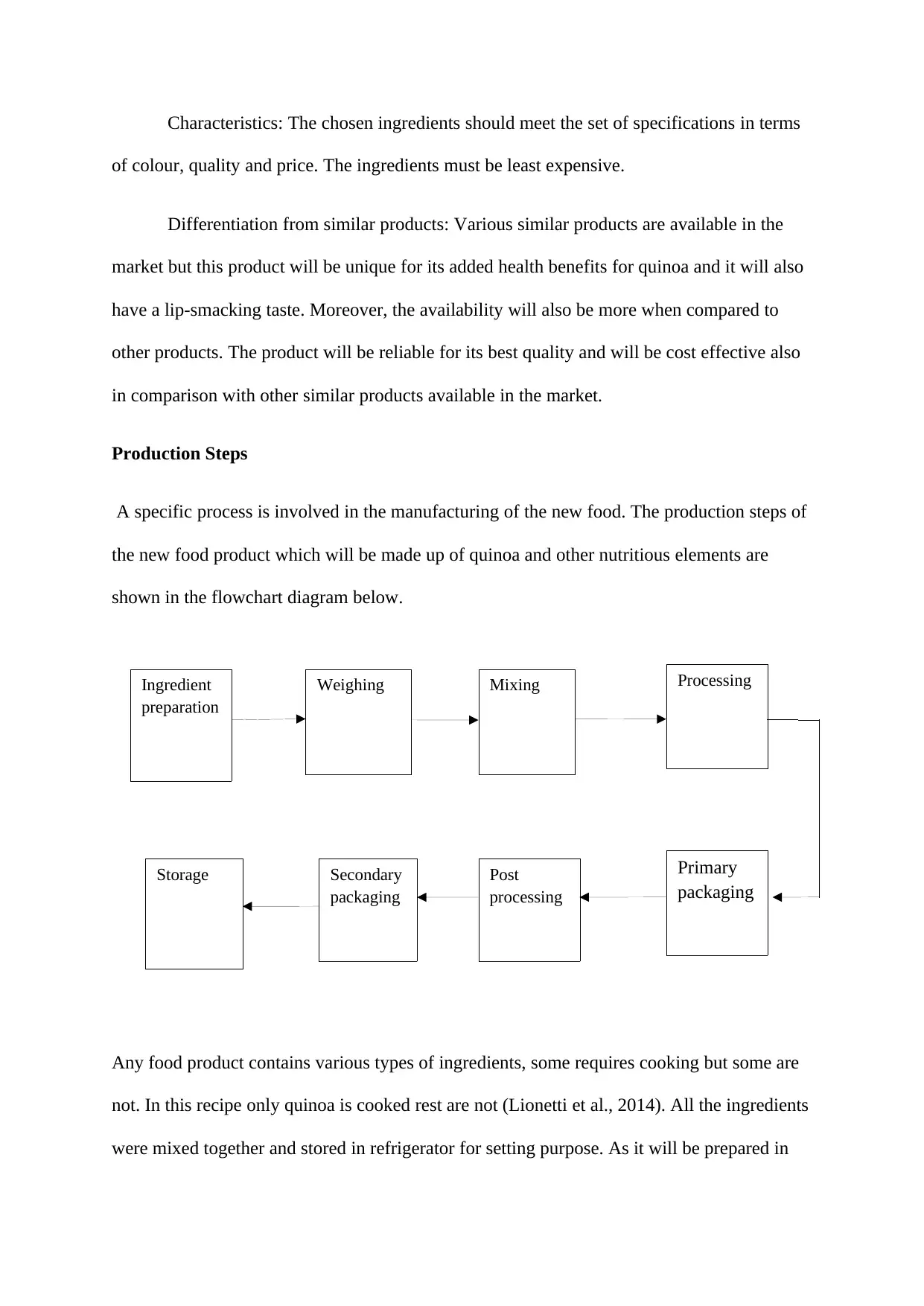
Characteristics: The chosen ingredients should meet the set of specifications in terms
of colour, quality and price. The ingredients must be least expensive.
Differentiation from similar products: Various similar products are available in the
market but this product will be unique for its added health benefits for quinoa and it will also
have a lip-smacking taste. Moreover, the availability will also be more when compared to
other products. The product will be reliable for its best quality and will be cost effective also
in comparison with other similar products available in the market.
Production Steps
A specific process is involved in the manufacturing of the new food. The production steps of
the new food product which will be made up of quinoa and other nutritious elements are
shown in the flowchart diagram below.
Any food product contains various types of ingredients, some requires cooking but some are
not. In this recipe only quinoa is cooked rest are not (Lionetti et al., 2014). All the ingredients
were mixed together and stored in refrigerator for setting purpose. As it will be prepared in
Ingredient
preparation
Weighing Mixing Processing
Storage Secondary
packaging
Post
processing
Primary
packaging
of colour, quality and price. The ingredients must be least expensive.
Differentiation from similar products: Various similar products are available in the
market but this product will be unique for its added health benefits for quinoa and it will also
have a lip-smacking taste. Moreover, the availability will also be more when compared to
other products. The product will be reliable for its best quality and will be cost effective also
in comparison with other similar products available in the market.
Production Steps
A specific process is involved in the manufacturing of the new food. The production steps of
the new food product which will be made up of quinoa and other nutritious elements are
shown in the flowchart diagram below.
Any food product contains various types of ingredients, some requires cooking but some are
not. In this recipe only quinoa is cooked rest are not (Lionetti et al., 2014). All the ingredients
were mixed together and stored in refrigerator for setting purpose. As it will be prepared in
Ingredient
preparation
Weighing Mixing Processing
Storage Secondary
packaging
Post
processing
Primary
packaging
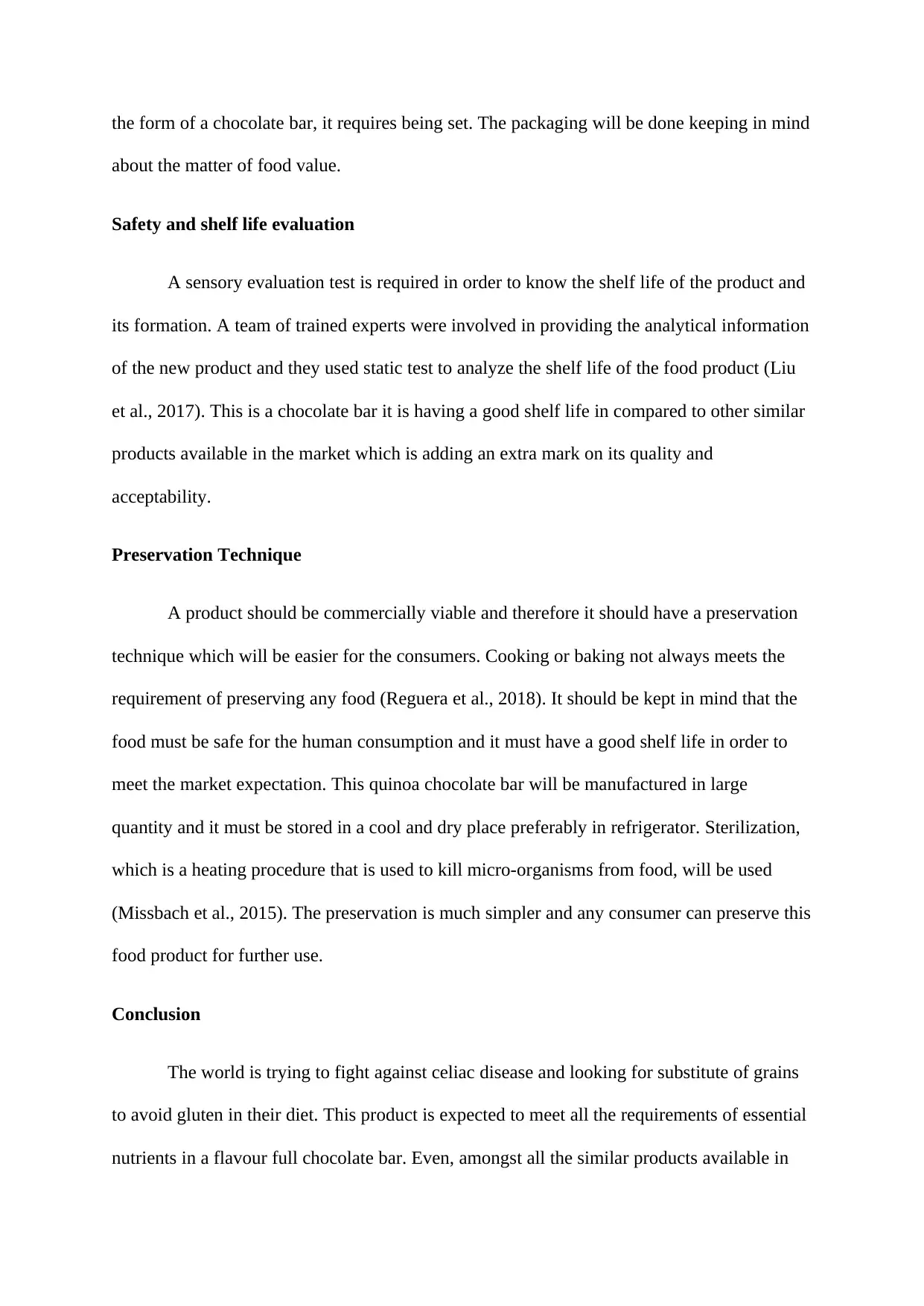
the form of a chocolate bar, it requires being set. The packaging will be done keeping in mind
about the matter of food value.
Safety and shelf life evaluation
A sensory evaluation test is required in order to know the shelf life of the product and
its formation. A team of trained experts were involved in providing the analytical information
of the new product and they used static test to analyze the shelf life of the food product (Liu
et al., 2017). This is a chocolate bar it is having a good shelf life in compared to other similar
products available in the market which is adding an extra mark on its quality and
acceptability.
Preservation Technique
A product should be commercially viable and therefore it should have a preservation
technique which will be easier for the consumers. Cooking or baking not always meets the
requirement of preserving any food (Reguera et al., 2018). It should be kept in mind that the
food must be safe for the human consumption and it must have a good shelf life in order to
meet the market expectation. This quinoa chocolate bar will be manufactured in large
quantity and it must be stored in a cool and dry place preferably in refrigerator. Sterilization,
which is a heating procedure that is used to kill micro-organisms from food, will be used
(Missbach et al., 2015). The preservation is much simpler and any consumer can preserve this
food product for further use.
Conclusion
The world is trying to fight against celiac disease and looking for substitute of grains
to avoid gluten in their diet. This product is expected to meet all the requirements of essential
nutrients in a flavour full chocolate bar. Even, amongst all the similar products available in
about the matter of food value.
Safety and shelf life evaluation
A sensory evaluation test is required in order to know the shelf life of the product and
its formation. A team of trained experts were involved in providing the analytical information
of the new product and they used static test to analyze the shelf life of the food product (Liu
et al., 2017). This is a chocolate bar it is having a good shelf life in compared to other similar
products available in the market which is adding an extra mark on its quality and
acceptability.
Preservation Technique
A product should be commercially viable and therefore it should have a preservation
technique which will be easier for the consumers. Cooking or baking not always meets the
requirement of preserving any food (Reguera et al., 2018). It should be kept in mind that the
food must be safe for the human consumption and it must have a good shelf life in order to
meet the market expectation. This quinoa chocolate bar will be manufactured in large
quantity and it must be stored in a cool and dry place preferably in refrigerator. Sterilization,
which is a heating procedure that is used to kill micro-organisms from food, will be used
(Missbach et al., 2015). The preservation is much simpler and any consumer can preserve this
food product for further use.
Conclusion
The world is trying to fight against celiac disease and looking for substitute of grains
to avoid gluten in their diet. This product is expected to meet all the requirements of essential
nutrients in a flavour full chocolate bar. Even, amongst all the similar products available in
⊘ This is a preview!⊘
Do you want full access?
Subscribe today to unlock all pages.

Trusted by 1+ million students worldwide

the market, this is unique because of its nutritious composition and an excellent shelf life.
The product is budget-friendly too. So, it is expected after screening and analysing this
product will be widely accepted by the people from all over the world.
The product is budget-friendly too. So, it is expected after screening and analysing this
product will be widely accepted by the people from all over the world.
Paraphrase This Document
Need a fresh take? Get an instant paraphrase of this document with our AI Paraphraser
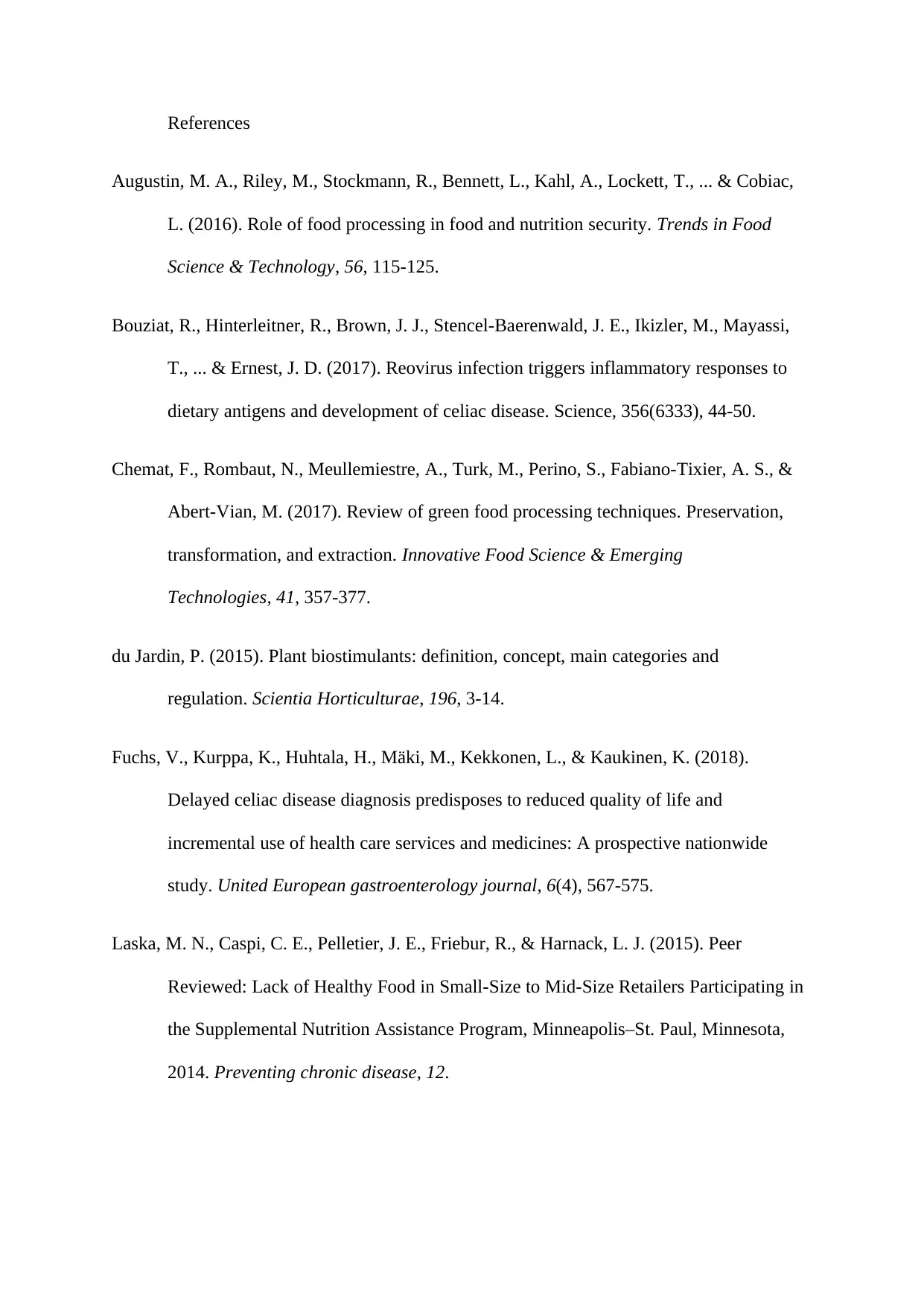
References
Augustin, M. A., Riley, M., Stockmann, R., Bennett, L., Kahl, A., Lockett, T., ... & Cobiac,
L. (2016). Role of food processing in food and nutrition security. Trends in Food
Science & Technology, 56, 115-125.
Bouziat, R., Hinterleitner, R., Brown, J. J., Stencel-Baerenwald, J. E., Ikizler, M., Mayassi,
T., ... & Ernest, J. D. (2017). Reovirus infection triggers inflammatory responses to
dietary antigens and development of celiac disease. Science, 356(6333), 44-50.
Chemat, F., Rombaut, N., Meullemiestre, A., Turk, M., Perino, S., Fabiano-Tixier, A. S., &
Abert-Vian, M. (2017). Review of green food processing techniques. Preservation,
transformation, and extraction. Innovative Food Science & Emerging
Technologies, 41, 357-377.
du Jardin, P. (2015). Plant biostimulants: definition, concept, main categories and
regulation. Scientia Horticulturae, 196, 3-14.
Fuchs, V., Kurppa, K., Huhtala, H., Mäki, M., Kekkonen, L., & Kaukinen, K. (2018).
Delayed celiac disease diagnosis predisposes to reduced quality of life and
incremental use of health care services and medicines: A prospective nationwide
study. United European gastroenterology journal, 6(4), 567-575.
Laska, M. N., Caspi, C. E., Pelletier, J. E., Friebur, R., & Harnack, L. J. (2015). Peer
Reviewed: Lack of Healthy Food in Small-Size to Mid-Size Retailers Participating in
the Supplemental Nutrition Assistance Program, Minneapolis–St. Paul, Minnesota,
2014. Preventing chronic disease, 12.
Augustin, M. A., Riley, M., Stockmann, R., Bennett, L., Kahl, A., Lockett, T., ... & Cobiac,
L. (2016). Role of food processing in food and nutrition security. Trends in Food
Science & Technology, 56, 115-125.
Bouziat, R., Hinterleitner, R., Brown, J. J., Stencel-Baerenwald, J. E., Ikizler, M., Mayassi,
T., ... & Ernest, J. D. (2017). Reovirus infection triggers inflammatory responses to
dietary antigens and development of celiac disease. Science, 356(6333), 44-50.
Chemat, F., Rombaut, N., Meullemiestre, A., Turk, M., Perino, S., Fabiano-Tixier, A. S., &
Abert-Vian, M. (2017). Review of green food processing techniques. Preservation,
transformation, and extraction. Innovative Food Science & Emerging
Technologies, 41, 357-377.
du Jardin, P. (2015). Plant biostimulants: definition, concept, main categories and
regulation. Scientia Horticulturae, 196, 3-14.
Fuchs, V., Kurppa, K., Huhtala, H., Mäki, M., Kekkonen, L., & Kaukinen, K. (2018).
Delayed celiac disease diagnosis predisposes to reduced quality of life and
incremental use of health care services and medicines: A prospective nationwide
study. United European gastroenterology journal, 6(4), 567-575.
Laska, M. N., Caspi, C. E., Pelletier, J. E., Friebur, R., & Harnack, L. J. (2015). Peer
Reviewed: Lack of Healthy Food in Small-Size to Mid-Size Retailers Participating in
the Supplemental Nutrition Assistance Program, Minneapolis–St. Paul, Minnesota,
2014. Preventing chronic disease, 12.
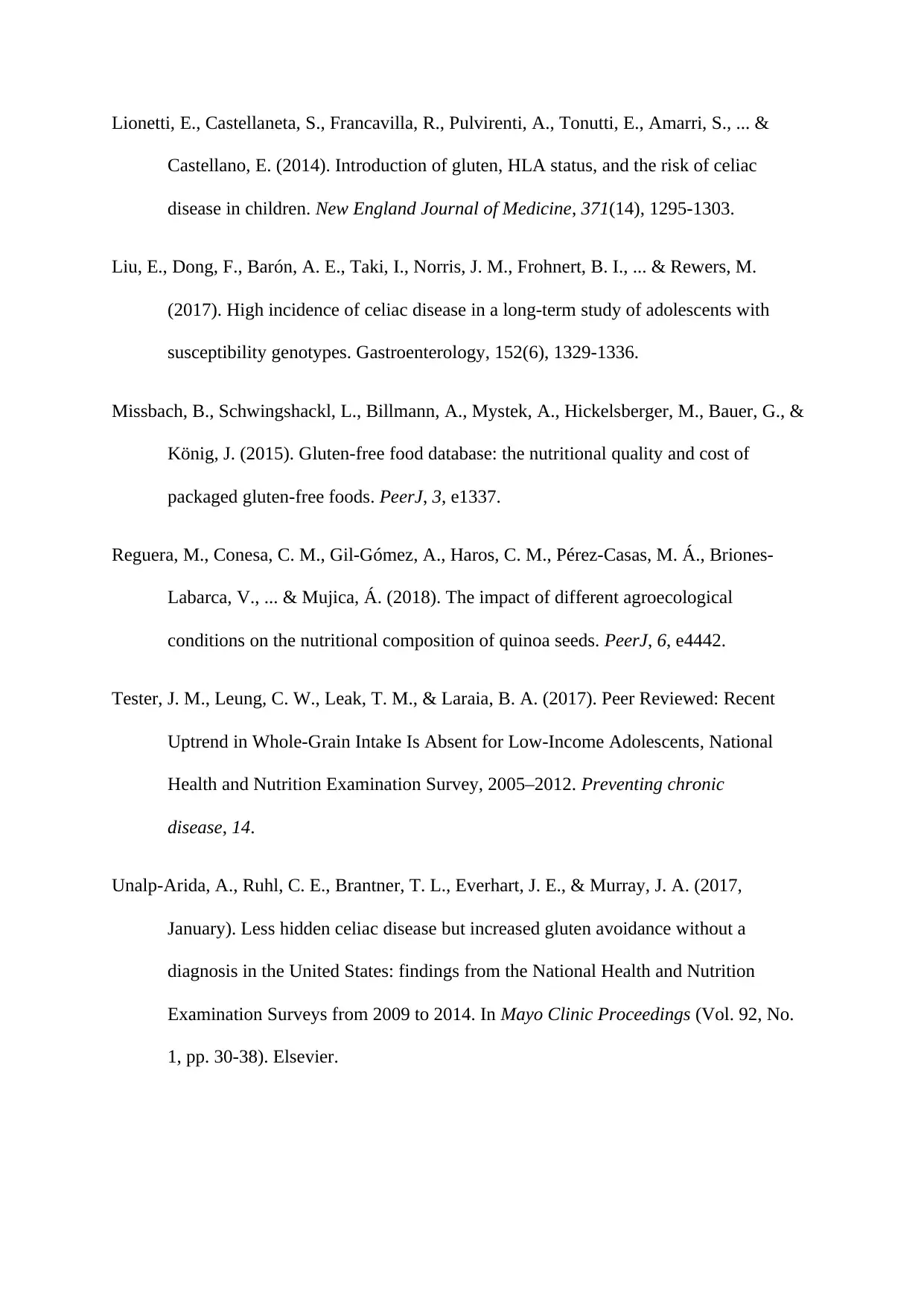
Lionetti, E., Castellaneta, S., Francavilla, R., Pulvirenti, A., Tonutti, E., Amarri, S., ... &
Castellano, E. (2014). Introduction of gluten, HLA status, and the risk of celiac
disease in children. New England Journal of Medicine, 371(14), 1295-1303.
Liu, E., Dong, F., Barón, A. E., Taki, I., Norris, J. M., Frohnert, B. I., ... & Rewers, M.
(2017). High incidence of celiac disease in a long-term study of adolescents with
susceptibility genotypes. Gastroenterology, 152(6), 1329-1336.
Missbach, B., Schwingshackl, L., Billmann, A., Mystek, A., Hickelsberger, M., Bauer, G., &
König, J. (2015). Gluten-free food database: the nutritional quality and cost of
packaged gluten-free foods. PeerJ, 3, e1337.
Reguera, M., Conesa, C. M., Gil-Gómez, A., Haros, C. M., Pérez-Casas, M. Á., Briones-
Labarca, V., ... & Mujica, Á. (2018). The impact of different agroecological
conditions on the nutritional composition of quinoa seeds. PeerJ, 6, e4442.
Tester, J. M., Leung, C. W., Leak, T. M., & Laraia, B. A. (2017). Peer Reviewed: Recent
Uptrend in Whole-Grain Intake Is Absent for Low-Income Adolescents, National
Health and Nutrition Examination Survey, 2005–2012. Preventing chronic
disease, 14.
Unalp-Arida, A., Ruhl, C. E., Brantner, T. L., Everhart, J. E., & Murray, J. A. (2017,
January). Less hidden celiac disease but increased gluten avoidance without a
diagnosis in the United States: findings from the National Health and Nutrition
Examination Surveys from 2009 to 2014. In Mayo Clinic Proceedings (Vol. 92, No.
1, pp. 30-38). Elsevier.
Castellano, E. (2014). Introduction of gluten, HLA status, and the risk of celiac
disease in children. New England Journal of Medicine, 371(14), 1295-1303.
Liu, E., Dong, F., Barón, A. E., Taki, I., Norris, J. M., Frohnert, B. I., ... & Rewers, M.
(2017). High incidence of celiac disease in a long-term study of adolescents with
susceptibility genotypes. Gastroenterology, 152(6), 1329-1336.
Missbach, B., Schwingshackl, L., Billmann, A., Mystek, A., Hickelsberger, M., Bauer, G., &
König, J. (2015). Gluten-free food database: the nutritional quality and cost of
packaged gluten-free foods. PeerJ, 3, e1337.
Reguera, M., Conesa, C. M., Gil-Gómez, A., Haros, C. M., Pérez-Casas, M. Á., Briones-
Labarca, V., ... & Mujica, Á. (2018). The impact of different agroecological
conditions on the nutritional composition of quinoa seeds. PeerJ, 6, e4442.
Tester, J. M., Leung, C. W., Leak, T. M., & Laraia, B. A. (2017). Peer Reviewed: Recent
Uptrend in Whole-Grain Intake Is Absent for Low-Income Adolescents, National
Health and Nutrition Examination Survey, 2005–2012. Preventing chronic
disease, 14.
Unalp-Arida, A., Ruhl, C. E., Brantner, T. L., Everhart, J. E., & Murray, J. A. (2017,
January). Less hidden celiac disease but increased gluten avoidance without a
diagnosis in the United States: findings from the National Health and Nutrition
Examination Surveys from 2009 to 2014. In Mayo Clinic Proceedings (Vol. 92, No.
1, pp. 30-38). Elsevier.
⊘ This is a preview!⊘
Do you want full access?
Subscribe today to unlock all pages.

Trusted by 1+ million students worldwide
1 out of 9
Related Documents
Your All-in-One AI-Powered Toolkit for Academic Success.
+13062052269
info@desklib.com
Available 24*7 on WhatsApp / Email
![[object Object]](/_next/static/media/star-bottom.7253800d.svg)
Unlock your academic potential
Copyright © 2020–2025 A2Z Services. All Rights Reserved. Developed and managed by ZUCOL.





